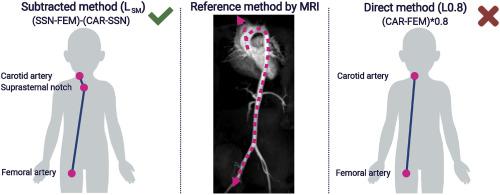当前位置:
X-MOL 学术
›
Atherosclerosis
›
论文详情
Our official English website, www.x-mol.net, welcomes your feedback! (Note: you will need to create a separate account there.)
Distance measurement for pulse wave velocity estimation in pediatric age: Comparison with intra-arterial path length
Atherosclerosis ( IF 5.3 ) Pub Date : 2020-06-01 , DOI: 10.1016/j.atherosclerosis.2020.04.026 György S Reusz 1 , Adrienn Bárczi 1 , Arianna Dégi 1 , Orsolya Cseprekál 2 , Éva Kis 3 , Ádám Szabó 4 , Monika Csóka 5 , Gábor Rudas 4 , Anna Végh 1 , Mohamed Temmar 6 , Paolo Salvi 7
Atherosclerosis ( IF 5.3 ) Pub Date : 2020-06-01 , DOI: 10.1016/j.atherosclerosis.2020.04.026 György S Reusz 1 , Adrienn Bárczi 1 , Arianna Dégi 1 , Orsolya Cseprekál 2 , Éva Kis 3 , Ádám Szabó 4 , Monika Csóka 5 , Gábor Rudas 4 , Anna Végh 1 , Mohamed Temmar 6 , Paolo Salvi 7
Affiliation

|
BACKGROUND AND AIMS
Central pulse wave velocity (PWV) is a marker of arterial stiffness and is calculated by dividing the pulse wave travel distance by the transit time. However, there is no consensus as to the ideal distance measurement in children. The aim of our study was to identify the more reliable method to assess the distance measurement in the pediatric age. METHODS
Carotid-femoral PWV was measured by applanation tonometry in 988 healthy children aged 6.5-19.9 years. Two different surface distances were assessed: the subtraction method, representing the distance from the suprasternal notch to the femoral artery minus the distance from the carotid artery to the suprasternal notch, and the direct method, consisting of 80% of the distance from the carotid artery to the femoral artery. Both these methods were compared with the actual path length determined by magnetic resonance imaging (MRI) in 31 children. RESULTS
Subtraction and direct methods were significantly correlated in patients aged <14 years and the corresponding PWV values showed a good agreement. In children aged ≥14 years, a significant difference between the two methods was found: subtraction - direct distance = -45 ± 28 mm, with a significant difference in the resulting PWV values = -0.57 ± 0.35 m/s (p < 0.0001). This result was confirmed by MRI, showing a 10% overestimation in distance measurement by the direct method in subjects aged ≥14 years, resulting in a significantly higher PWV. CONCLUSIONS
These data suggest a greater reliability of the subtractive method of distance measurement compared to the direct method in children.
中文翻译:

儿科脉搏波速度估计的距离测量:与动脉内路径长度的比较
背景和目的 中心脉搏波速度 (PWV) 是动脉僵硬度的标志,通过将脉搏波传播距离除以传播时间来计算。然而,对于儿童理想的距离测量还没有达成共识。我们研究的目的是确定更可靠的方法来评估儿科年龄的距离测量。方法采用压平眼压法测量988名6.5-19.9岁健康儿童的颈-股PWV。评估了两种不同的表面距离:减法法,代表从胸骨上切迹到股动脉的距离减去从颈动脉到胸骨上切迹的距离,以及直接法,由距颈动脉的距离的 80% 组成到股动脉。这两种方法都与 31 名儿童的磁共振成像 (MRI) 确定的实际路径长度进行了比较。结果 减法法和直接法在<14 岁的患者中显着相关,相应的PWV 值显示出良好的一致性。在 14 岁以上的儿童中,发现两种方法之间存在显着差异:减法 - 直接距离 = -45 ± 28 mm,所得 PWV 值的显着差异 = -0.57 ± 0.35 m/s (p < 0.0001) . 这一结果得到了 MRI 的证实,表明在 14 岁以上的受试者中,直接法测量距离高估了 10%,导致 PWV 显着升高。结论 这些数据表明,与儿童的直接方法相比,距离测量的减法方法具有更高的可靠性。
更新日期:2020-06-01
中文翻译:

儿科脉搏波速度估计的距离测量:与动脉内路径长度的比较
背景和目的 中心脉搏波速度 (PWV) 是动脉僵硬度的标志,通过将脉搏波传播距离除以传播时间来计算。然而,对于儿童理想的距离测量还没有达成共识。我们研究的目的是确定更可靠的方法来评估儿科年龄的距离测量。方法采用压平眼压法测量988名6.5-19.9岁健康儿童的颈-股PWV。评估了两种不同的表面距离:减法法,代表从胸骨上切迹到股动脉的距离减去从颈动脉到胸骨上切迹的距离,以及直接法,由距颈动脉的距离的 80% 组成到股动脉。这两种方法都与 31 名儿童的磁共振成像 (MRI) 确定的实际路径长度进行了比较。结果 减法法和直接法在<14 岁的患者中显着相关,相应的PWV 值显示出良好的一致性。在 14 岁以上的儿童中,发现两种方法之间存在显着差异:减法 - 直接距离 = -45 ± 28 mm,所得 PWV 值的显着差异 = -0.57 ± 0.35 m/s (p < 0.0001) . 这一结果得到了 MRI 的证实,表明在 14 岁以上的受试者中,直接法测量距离高估了 10%,导致 PWV 显着升高。结论 这些数据表明,与儿童的直接方法相比,距离测量的减法方法具有更高的可靠性。



























 京公网安备 11010802027423号
京公网安备 11010802027423号